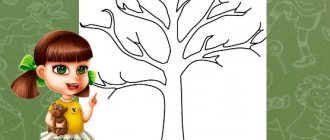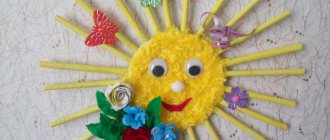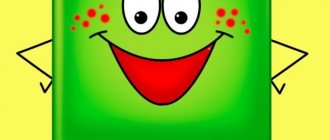Hare made from natural materials
We will combine autumn herbarium and cereals. Take semolina or rice, a couple of sunflower seeds, a few buckwheat pieces and the herbarium you collected:
- Draw a stencil of the animal. The herbarium sticks well with regular PVA glue.
- Decorate the body with rice, the eyes and nose with black seeds, and the claws will be in the shape of buckwheat.
- Decorate the background with autumn leaves. Additionally, you can paint the rice with gouache and trim the carrots for the hare.
Even a preschooler can do it with a little help. Senior assistants work with very young children to avoid injury: small children can swallow small parts or be injured by scissors.
Creating a bunny using the appliqué technique is possible from everything you have at hand. The technology differs by age; in some moments of creating a children's masterpiece, supervision and help are needed. They are available to anyone who has cereals or cotton wool with colored paper in their house. The bunny will also serve as a creative project for a child in kindergarten or school.
Hare made of geometric shapes
In the younger group of kindergarten, the teacher needs to prepare in advance details in the form of various triangles, circles, squares and rectangles for the lesson. It is more interesting for children to experiment with patterns made from colored paper. If you carefully print out a diagram for gluing geometric elements and show examples of finished work, then children's creative work will be more focused.
The hare applique can be made not only on the basis of the standard contour of a hare figurine or a muzzle with ears. You can use your imagination and figure out how to make an abstract bunny applique from geometric shapes.
Summary of GCD in the second junior group of the kindergarten “Bunny and Snowflakes”
Dear friends, we are pleased to once again introduce you to Tatyana Viktorovna Solovykh, teacher of the joint venture “Kindergarten No. 29 “Korablik” of State Budgetary Educational Institution Secondary School No. 13 of the city. Chapaevsk, Samara region . Today Tatyana Viktorovna is pleased to bring to your attention the Summary of the GCD in the second junior group of the kindergarten “Bunny and Snowflakes”. The article will be of interest to preschool teachers and parents.
A short commentary on the article from Tatyana Viktorovna:
“Tasks: Cognitive development: to develop the ability to identify signs in an object. Arouse interest in nature. Introduce the habits of a hare. Give an idea of the seasonal changes in the life of a hare. Speech development: enrichment of active vocabulary, development of dialogic speech. Social and communicative development: development of communication and interaction of a child with adults and peers, emotional responsiveness, empathy.”
Interesting reading...
Summary of GCD in the second junior group of the kindergarten “Bunny and Snowflakes”
Integration of educational areas:
Cognitive development, speech development, social and communicative development, physical development, artistic and aesthetic development.
Tasks:
Cognitive development: to develop the ability to identify signs in an object. Arouse interest in nature. Introduce the habits of a hare. Give an idea of the seasonal changes in the life of a hare.
Speech development: enrichment of active vocabulary, development of dialogic speech.
Social and communicative development: development of communication and interaction of the child with adults and peers, emotional responsiveness, empathy.
Physical development: improve children’s spatial orientation, encourage participation in joint games and physical exercises.
Artistic and aesthetic development: to develop in children the ability to fold strips in half, to stimulate empathy for game characters, to evoke a desire to help them.
Methods and techniques: visual, verbal, practical; conversation, literary expression, play actions, teacher's story, helping children with difficulties, demonstration.
Equipment: bunny - a soft toy in a wonderful bag, birch stump, candy, carrots, cabbage, fox mask, hare masks.
Materials for work: 3 strips of 1 * 19 cm of white paper, paste, glue brushes, pencil, napkins, coasters.
Preliminary work: examining and drawing snowflakes, experiments with water, snow, games and fun with snow. Outdoor games “The little white bunny is sitting”, “Be careful - I’ll freeze you!”, “Snowflakes and the wind”.
GCD logic:
Children sit on the carpet in a semicircle. A few meters away from them there are tables with materials for manual labor.
Educator.
— Guys, we have guests in our kindergarten today. Let's say hello to them. They brought us this beautiful bag from the forest; to open it, we need to solve a riddle:
He rushes without looking back, only his heels sparkle, he runs as fast as he can, his tail is shorter than his ear. Guess quickly: who is it? (bunny)
The teacher takes out a bunny from a wonderful bag.
- Look, guys, what an elegant fur coat the bunny has. What color is it? (white as snow). In summer the bunny had a gray fur coat. It was convenient to hide in the shade under the bushes. And when the snow fell, the bunny put on a white fur coat so that he could hide from the fox in the snow. When a fox chases a hare, he tries to confuse his tracks. The bunny will jump onto the stump, press his ears, close his eyes and sit quietly, like a white snowball lying on the stump. The fox runs for a long time in the tracks of the hare, but cannot find him. The fox gets tired and goes into the forest.
- Can we hide from the fox? Let's try.
Outdoor game "Fox and Hares".
1. Hares are jumping on the lawn.
2. The fox woke up. The hares squatted down and hid.
3. Hares are running away from the fox.
Hare: It’s good for you to hide from the fox. But what should I do? After all, there is no snow in the forest, and on the black wet path the fox will immediately find and eat me. (crying) Teacher. Don't cry, little bunny. Do you want some candy?
Hare. No. Hares don't eat sweets.
Educator. What do hares eat?
Children. Cabbage, carrots.
Educator. Don't cry, little bunny. We will help you. We will teach you how to make snowflakes.
(Children sit at tables)
Educator.
- Look, bunny, carefully and remember. First you need to fold all the strips in half to find the middle (exercise “Hello, pens”). I will mark the middle for you with a pencil so that it does not get lost when gluing. First, we will glue together a mustache from two strips, like a cat’s mustache of amazing beauty. Glue another strip in the middle. Here are some snowflakes for you, little bunny.
Hare. So cold, even my paws were frozen. Let's play.
Outdoor game "Snowflakes".
(The hare thanks the children for the snowflakes).
Educator.
- Guys, what kind of guest did we have? Why does he have a white fur coat in winter? What have we learned to do?
— Guys, we had a very fun and interesting time, you played so well. For this, the bunny has prepared a surprise for you. (The hare shows a chest of sweets). The children thank you for the treat.
Bunny made of cotton pads
We will master a simple method for the little ones. Prepare plasticine green and pink (red), thin sticks (or spaghetti), sponges 6 pcs. Glue a full circle of cotton wool into the center of the cardboard - this is the body of the hare. Take one half and fold it in half. This is how the ear turned out. Repeat one more time. The paws will be created using halves of circles bent in half. All that remains is to glue on the eyes and nose from plasticine, the spaghetti mustache and the bunny is ready. This type of work is suitable even for children 3-4 years old.
For older children we create three-dimensional figures. To do this, the sponges are glued together and figuratively glued onto cardboard. Here's an idea for a voluminous product.
Summary of a lesson on artistic creativity (application) in the 2nd junior group of kindergarten
Summary of a lesson on artistic creativity in the second junior group. Application on the theme: “Cubes for the bunny”
Summary of a lesson on artistic creativity in the second junior group.
Application on the theme: “Cubes for the bunny” Goal . Strengthen the ability to stick multi-colored cubes of different sizes and colors. Arouse positive emotions from work. Objectives : • Educational: to consolidate the idea of a geometric figure - a square; improve the ability to arrange objects by color; consolidate gluing techniques. • Developmental: develop speech, memory, attention, thinking. • Educational: continue to instill in children responsiveness, sympathy for fairy-tale characters, and create a desire to help them. Materials and equipment: • plastic cubes (red, yellow, green, blue); • tray; • 4 baskets; • a sheet of white paper with a picture of a bunny (for each child); • cut out squares of different colors (for each child); • glue, brushes, napkins (for each child); • box with inflatable balloons; • balloons. Progress of the lesson. Children enter the group. There are plastic cubes of different colors on a large tray. Educator: Guys, what is this? (Cubes). - There are so many of them. And how beautiful they are! – Who can tell me what color these cubes are? (Children's answers) Educator: Oh, guys, look, the cubes have scattered (pour out on the floor). They probably want to play with you. Invite the children to collect the cubes. And put cubes in the basket of the same color as the color of the basket. Check with the children that all the cubes are in their basket. There's a knock on the door. Educator: Someone came to us (Opens the door, and there is a bunny). Bunny. (Sad) - Hello, guys! Children say hello. Educator: – What is the bunny’s mood? (sad, sorrowful). – Why do you think? (Children's answers). - And he’s sad because he wants to play, but he doesn’t have any cubes. Shall we help him have fun? You have colorful squares on your table and everything you need to stick them on. This must be done beautifully and carefully. Then he will become cheerful. – Show how the bunny will build with cubes. (Children design). - Now let's get to work. As you work, ask the children where they will stick the cubes (up, down, above, below). Educator: What do you think the bunny’s mood is now? (Cheerful, joyful). – Yes, he smiles at us and says thank you for the beautiful, colorful cubes. And he also has a surprise for you. Take the balls out of the box and invite the children to play with them.
We recommend watching:
Synopsis of an integrated lesson on cognitive development in the 2nd junior group “Journey to the village” Synopsis of a lesson on ecology in the 2nd junior group Synopsis of an open lesson in the 2nd junior group Synopsis of an integrated lesson on the fairy tale Teremok in the 2nd junior group of kindergarten.
Similar articles:
Abstract of GCD in the second junior group in valeology
GCD summary for kindergarten on the topic: “I’m growing”
Summary of GCD for preschool educational institutions on the topic: “Our legs”
Summary of GCD for kindergarten on the topic: “Our hands”
Summary of GCD in a preschool educational institution on the topic: “Our language”





